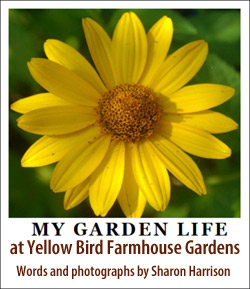Under the humming linden tree, and the enchanted woodland place
Administrator | Jul 20, 2025 | Comments 0
 The lovely large linden tree that graces my property is out-performing this summer when it comes to blossoms, where it doesn’t seem affected by any lack of moisture these past many weeks, or the abundance of heat -or perhaps it thrives because of it. It flowered last year, a little, but this year, the big old tree is heavy with blooms, from top to toe.
The lovely large linden tree that graces my property is out-performing this summer when it comes to blossoms, where it doesn’t seem affected by any lack of moisture these past many weeks, or the abundance of heat -or perhaps it thrives because of it. It flowered last year, a little, but this year, the big old tree is heavy with blooms, from top to toe.
And they are not insignificant blooms either, but large pendulous things, the creamy yellow hue covering the massive tree almost entirely. For an older tree, it has put on significant growth in just the last year or so, where it seems happy to keep growing, to expand its footprint and canopy, and it seems quite content where it grows.
Those blossoms, each pendulum with six or eight or more individual flowers, could be well-suited as an opulent chandelier hanging in an equally opulent home, and not only look quite spectacular, but they are also slightly deliciously fragrant, not overpoweringly so, not too sweet, not at all musky or pungent, but rather divine.
 I like to stand under the canopy of the linden tree often, the coolness and darkness of the rich woodland makes it feel a special place, on this my first encounter with a linden tree. And I marvel at how a huge tree can be covered in so many flowers, the sheer number of pendulous blossoms hanging from its countless branches, the movement mesmerizing with just the slightest breeze, and it reminds me of dancing ladies or little ballerinas with full skirts gaily bouncing to the rhythm of life.
I like to stand under the canopy of the linden tree often, the coolness and darkness of the rich woodland makes it feel a special place, on this my first encounter with a linden tree. And I marvel at how a huge tree can be covered in so many flowers, the sheer number of pendulous blossoms hanging from its countless branches, the movement mesmerizing with just the slightest breeze, and it reminds me of dancing ladies or little ballerinas with full skirts gaily bouncing to the rhythm of life.
 But it is when I am underneath this fine specimen that I hear the humming sound above me. Bees and many different insects clutch to the blooms for prolonged lengths of time, as if glued there, almost disappearing inside the individual flowers, seeming to linger longer than they would with any other flower. While I observe just a few bees, I hear much more above me, the cumulative and constant humming and buzzing a sign there is much going on that I cannot see from down here at ground level.
But it is when I am underneath this fine specimen that I hear the humming sound above me. Bees and many different insects clutch to the blooms for prolonged lengths of time, as if glued there, almost disappearing inside the individual flowers, seeming to linger longer than they would with any other flower. While I observe just a few bees, I hear much more above me, the cumulative and constant humming and buzzing a sign there is much going on that I cannot see from down here at ground level.
It turns out the linden tree is a haven for attracting native bees, honey bees too, and other pollinators who, along with getting a nectar fix as the tree is a valuable source, they pollinate the trees – some even call it the bee tree because around mid-July when it begins to flower, bees flock to it, intoxicated by the experience. So hence the constant humming to be heard when nearby or standing just beneath the clusters of chandelier flowers where countless insects are enjoying the nectar source, as I am enjoying the wondrous humming linden tree.
 Also known as an American basswood or American linden (Tilia Americana), somehow I like the word linden better, and I like this tree, not least because it has enormous serrated heart-shaped leaves (small ones too, but many are larger than my outstretched hand) – its many hearts not lost on me either. It’s an interesting tree because it’s always doing something different. Some trees just stay the same, don’t do much, they don’t change much or grow much, but the linden tree fascinates because it provides constant interest. It feels engaged, and as a result, that makes me feel engaged too.
Also known as an American basswood or American linden (Tilia Americana), somehow I like the word linden better, and I like this tree, not least because it has enormous serrated heart-shaped leaves (small ones too, but many are larger than my outstretched hand) – its many hearts not lost on me either. It’s an interesting tree because it’s always doing something different. Some trees just stay the same, don’t do much, they don’t change much or grow much, but the linden tree fascinates because it provides constant interest. It feels engaged, and as a result, that makes me feel engaged too.
I also recently learned through some research that the genus belongs to the hibiscus (or mallow) family, which is neat because while it resembles hibiscus in absolutely no way to my eye, it too has long been high on my favourites list. One of my most cherished indoor plants is a standard red hibiscus that must be about 20 years old (and it is going mad with new growth in this hot summer, something it hasn’t done in years). The linden tree is also native to not only North America but Ontario (especially the south), which is yet another tick for this wondrous tree.
 My linden tree, and there really are many linden trees in the same spot, a big old tree surrounded by lots of saplings that are a significant size in themselves, where they all exist happily together it appears, within what I like to call an enchanting woodland place, a secret grove of sorts. Its a little woodland dominated by the big linden tree and its many babies (and there are many), under planted with smaller shrubs on the periphery, of lilac and sumac and others, and at ground level, countless ferns and violets and such.
My linden tree, and there really are many linden trees in the same spot, a big old tree surrounded by lots of saplings that are a significant size in themselves, where they all exist happily together it appears, within what I like to call an enchanting woodland place, a secret grove of sorts. Its a little woodland dominated by the big linden tree and its many babies (and there are many), under planted with smaller shrubs on the periphery, of lilac and sumac and others, and at ground level, countless ferns and violets and such.
I was drawn to this little grove, this most secret little place, from the moment I saw it, where I was invited inside to hide away under the enormously long low-hanging branches, shading all sunlight, where it’s almost always dark here, the canopy so dense, it blocks most of the sunlight, allowing only a few dapples to penetrate. I share this special place with others, with birdlife and insects, and wildlife too, including the local racoon population who like to hang out here at night.
It’s a place that makes you just want to linger, to never leave, where the deep shade is so very welcome (and not at all unfriendly), especially in this hot, dry summer season: a cool spot in more ways than one. It’s also a great place to be during a rain storm, feeling sheltered and secure, but also, with a dense foliage canopy, the rain barely penetrates, eventually working its way through, not in streams as you would imagine, but splatters of raindrops find a way in, eventually.
The bark of the main tree intrigues me too, deeply indented with ridges, and yet the immature linden trees beside have completely smooth bark of a much lighter, almost grey colour, compared to the dark brown rutting of the large tree. Underfoot, the ground is soft and almost spongy, the soil peaty and organic and rich (and it smells wonderfully peaty too), no doubt from years and years of linden leaves (and other leaves) falling and decaying season-after-season. I also learned that linden leaves are very rich in nutrients, compared to many other trees.
Old stumps exist here too in this secret little grove, at least three major ones, the size of the present tree in circumference which were either cut down at some point, or fell down, and perhaps for all I know, this tree grew out of those trees. The stumps are no longer stumps as such, but hollow bases standing about a foot high, the innards rotted and crumbling to peaty organic matter, deep in colour and rich in every way. In a few short years, they will be gone completely, no longer existing having served their purpose, the stumps having given back to the earth where they stood, likely for many decades.
I also learned recently that it’s quite common to find a grove of linden trees growing close together because when a linden tree is cut down, it’s designed to produce more trees, something I am now certain has happened here given the presence of the old stumps, and the young lindens growing in the very same spot.
On first appearance, there appears no way into the centre of this enchanted place, so dense is the surrounding foliage, and so low are the linden’s branches, that dare to scrape the woodland floor. Yet there are a few ways in, and once under the canopy which opens right up in a cavernous way inside, it feels special.
Don’t ask me to describe what that means because I don’t know exactly, but it feels like a privileged spot, maybe a spiritual place, and it’s the only area on the property that provides that same feeling, where I was drawn to it the moment I discovered it was more than just a lovely big tree in the shadow of the house. It’s calm there, peaceful, a gentle healing place that holds something good.
 There is a gracefulness to the structurally elegant linden, despite its branches growing in different directions, a bit haphazardly sometimes, some oddly horizontal and not always straight, but with strange yet interesting twists, its lower-most younger limbs almost wispy and manoeuvrable and often unusually long and flexible. But it is also the branches of the young lindens that fascinate as they begin at ground level, where they seem to reach out, invitingly so, to welcome those passing by.
There is a gracefulness to the structurally elegant linden, despite its branches growing in different directions, a bit haphazardly sometimes, some oddly horizontal and not always straight, but with strange yet interesting twists, its lower-most younger limbs almost wispy and manoeuvrable and often unusually long and flexible. But it is also the branches of the young lindens that fascinate as they begin at ground level, where they seem to reach out, invitingly so, to welcome those passing by.
Without those lower limbs and dense foliage, this enchanted woodland place would not be the secret grove it is, and for that I am grateful for the majestic tree and its odd shape and plentiful foliage and sprawling branches, and especially all the young trees growing here too. It offers a pleasing silhouette, despite the almost random growth pattern, as the tree grows just as it wants to, in a somewhat non-conforming but very pleasing way.
Click here for more gardening columns by Sharon Harrison
– A gardener all her adult life, and much of her childhood, Sharon Harrison blames her parents for this predicament, both of whom are life-long gardeners and growers of good things, nonetheless grateful for the gardening genes, and the growing passion.
While she has written on countless topics over many years for numerous publications and media, her heart remains rooted in her Prince Edward County garden as a grower of beautiful, strange and sometimes ordinary things, inspired and influenced by nature, wildlife and the fragility of environment.
Filed Under: News from Everywhere Else • Sharon Harrison
About the Author:

































